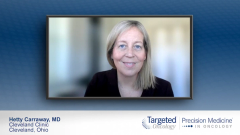
Overview of Acute Myeloid Leukemia (AML)
Eytan Stein, MD, provides a brief overview of acute myeloid leukemia.
Episodes in this series

Hetty Carraway, MD: Hello, and thank you for joining this Targeted Oncology™ presentation titled “Frontline Treatment of Acute Myeloid Leukemia.” I’m Hetty Carraway, a professor of medicine at the Cleveland Clinic Lerner College of Medicine of Case Western Reserve University at Cleveland Clinic in Cleveland, Ohio. Joining me is my esteemed colleague, Dr Eytan Stein. I’d like to invite Dr Stein to introduce himself.
Eytan Stein, MD: Thanks so much, Dr Carraway. My name is Eytan Stein and I’m an attending physician and the director for the program for drug development in leukemia and the leukemia service at Memorial Sloan Kettering Cancer Center in New York City.
Hetty Carraway, MD: Thank you so much for joining me. In this precision medicine and oncology discussion, we’ll talk about frontline treatment options for patients with AML [acute myeloid leukemia] and how to select the appropriate treatment based on the patient and disease factors. Let’s begin.
Eytan Stein, MD: I’m going to start by giving a quick overview of acute myeloid leukemia. First of all, acute myeloid leukemia is a relatively rare malignancy if you think about the incidence of AML compared with the incidence of more common cancers, such as breast cancer and prostate cancer. Acute myeloid leukemia occurs in about 20,000 patients per year in the United States. The incidence of this disease is rising as the population ages. Many of you know that acute myeloid leukemia is a disease primarily of older adults, with most adults being diagnosed with acute myeloid leukemia between the ages of 65 and 74 years.
The biology of acute myeloid leukemia is such that there are stem cells in patients’ bone marrows that develop mutations that lead to the block in myeloid differentiation, such that myeloid myeloblasts accumulate to over 20%, which is the definition of acute myeloid leukemia. The accumulation of those myeloblasts and other changes that happen in the bone marrow essentially lead to bone marrow collapse, with the inability of the bone marrow to produce healthy, functioning neutrophils, platelets, and red blood cells.
The treatment of acute myeloid leukemia is a heartening story in that patients over the course of the past 10 years have benefited from many new treatments and a new understanding of the underlying biology of the disease. However, it’s still a disease where there’s a great deal of medical need, with the mortality being unacceptably high. We talk about favorable-risk acute myeloid leukemia being those patients who have an overall survival of about 70% to 80% at 5 years. Certainly, we want the overall survival to be much higher than that.
Transcript edited for clarity.












































